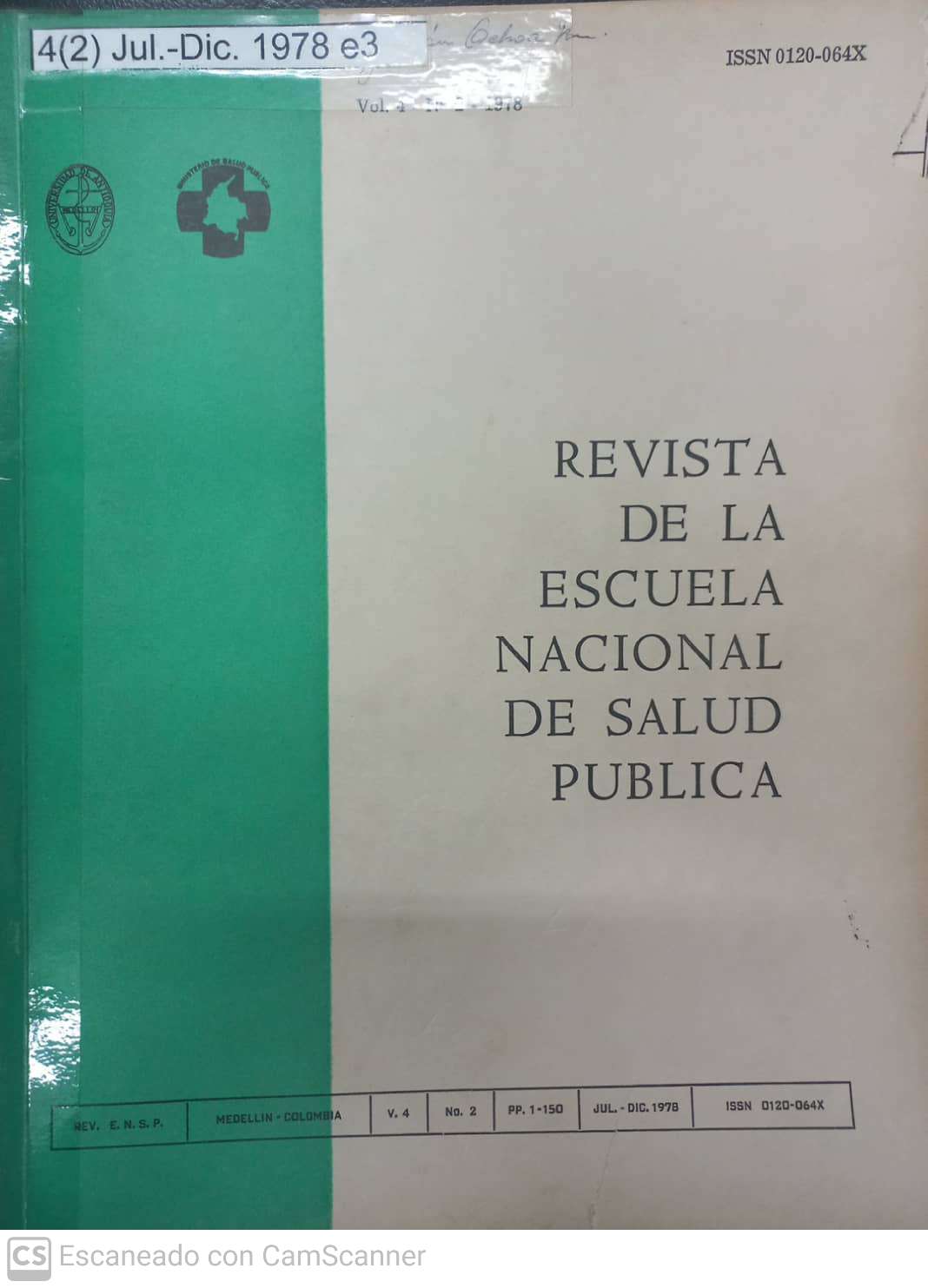INCORPORACION DE LAS CIENCIAS SOCIALES AL CAMPO DE LA SALUD EN CHILE
Primeras Experiencias 1964-1973
Resumen
El propósito de este trabajo es reflexionar en torno al papel real que las ciencias sociales jugaron y pueden jugar en el campo de la salud, a base de nuestra experiencia personal de una década, bruscamente interrumpida. El esfuerzo ha estado dirigido, en circunstancias adversas, a identificar aquellos elementos más relevantes que hicieron posible que las ciencias socia- les alcanzaran, en esta área, un alto grado de importancia por todos reconocido. La breve distancia temporal permite redondear todavía con frescura, y ya con más objetividad, el proceso vivido, y sus perspectivas futuras.
Espera contribuir, así, a la búsqueda permanente de modalidades de relación entre las ciencias sociales y salud, en otras circunstancias y países, tanto en el plano de los contenidos, como en el plano institucional.
El desarrollo de las ciencias sociales en el campo de la salud está vinculado a ciertas características estructurales del proceso social chileno, que trataremos de rescatar en sus rasgos más sobresalientes, de modo sumario en esta Introducción y, con cierto detalle, para cada una de sus tres Etapas.
Descargas
Citas
Para un análisis más detenido del tema, ver: GARRE- TON, M.A. y MORALES, E.J. Políticas sociales y papel redistributivo del Estado en América Latina. Santiago, FLACSO, 1976.
Un estudio pionero en ese campo es ALLENDE, S. La realidad médico-social Chilena, Santiago, Auro- ra, 1939. Otra expresión es el primer texto de salud pública producido en América Latina por otro médico de esa generación, MOLINA, G. y ADRIASOLA, E. Principios de administración sanitaria; teoría y práctica de la Salubridad en América Latina, Santiago, Universidad de Chile, 1955.
JADRESIC, A. La reforma universitaria y la Facultad de Medicina. Revista de Educación Nos, 15-16, 1969.
Ibid.
Ibid,
VASCONI, T. y RECA, I. Movimiento estudiantil y crisis de la Universidad de Chile, In: Chile hoy. México, Siglo XXI, 1970.
JADRESIC, op cit.
ORGANIZACION MUNDIAL DE LA SALUD. Report of a study group on internally acceptable mini- mun standards of medical education, Geneva, 1961. (Informe Técnico, 239).
-. Training of the physician for family practice. Geneva, 1963. (Informe Técnico, 257).SEMINARIOS SOBRE LA ENSEÑANZA DE MEDI- CINA PREVENTIVA, Viña del Mar, 1955. In- forme, Washington, Oficina Sanitaria Panamericana, 1957. (Publicación Científica, 28).
Declaración de principios sobre los propósitos de la Educación Médica. Escuela de Medicina. Universidad de Chile, 1960,
(X)Damos por superada la discusión inicial sobre qué disciplinas integran el rubro ciencias sociales o ciencias de la conducta a la luz de desarrollos posteriores que, al definir las áreas o problemas a que éstas deben contribuír, implícita o explícitamente definen cuáles son las disciplinas re- queridas.
BADGLEY, R.B. and SCHULTE, M. Social Science teaching programs in latin american medical
schools, Milbank Memorial Fund Quarterly 44(2), 1966.
(X) El Hospital San Borja es el Hospital Base del Area Central, una de las 5 áreas urbanas de salud de Santiago. Pertenece al Servicio Nacional de Salud (SNS) y en él se forman médicos y otro personal mediante la confluencia de recursos y personal de la U. de Chile y del SNS. Este pro- grama además de contar con el apoyo del SNS y la U. de Chile, despertó el interés de organismos extranjeros e internacionales. A partir de 1965 la Fundación Milbank contribuye a la contratación del personal de ciencias sociales a través de un "Programa para el desarrollo de las ciencias sociales en el campo de la salud".
MOLINA, G. y JIMENO, C. Teaching social science concepts in clinical setting in preventive medicine. Milbank Memorial Fund Quarterly 44(2), 1966.
(X) La Ficha Epidemiológica - social contiene una serie de datos útiles al interés clínico agrupados en 7 rubros: nivel de instrucción, ocupación, ingresos y seguridad social, hábitos personales y nutrición, actitudes y personalidad, vivienda y grupo familiar y costo de la enfermedad.
MOLINA, G. Evaluación de la enseñanza preventiva y social integrada en las clínicas. Educación Médica y Salud 1(2): 67-84, Mar. 1967.
GARCIA, J.C. La educación médica en A. Latina. Washington, Oficina Sanitaria Panamericana, 1972. 413 p. (Publicación Científica, 255).
MORALES, E. El estudiante de medicina y su imagen de la profesión. Revista Hospital San Borja 1(1), 1966.
El trabajo más serio en este sentido fué el "Formulario de Nota de Concepto" aplicado en la calificación de los alumnos de clínica. O. Soto y GloriaMolina (Mimeografiado Cátedra de Medicina "A"-H. San Borja, 1965).
(X) Las unidades coinciden con las 5 áreas urbanas de salud de Santiago cada una de las cuales cuenta con un Hospital Base de Adultos y un Hospital Pediátrico en donde se realiza la enseñanza.
UNIVERSIDAD DE CHILE. FACULTAD DE MEDICINA. Propósitos y objetivos generales de la docencia en la Facultad. En: Anuario Escuela de Medicina, 1970.
Objetivos específicos de la carrera de medicina. En: Anuario Escuela de Medicina, 1970.
Hasta ahora se incorporaban sólo a partir del 40, año de la carrera.
Programas docentes, área central, 1970.
(X)La Fundación Milbank otorga un Grant docente y de investigación a los tres cientistas sociales más antiguos del grupo.
UNIVERSIDAD DE CHILE, FACULTAD DE MEDICINA. Planes de estudios de las carreras de Obstetricia y Enfermería del área central, 1971.
Descargas
Publicado
Cómo citar
Número
Sección
Licencia
Derechos de autor 2025 Gloria Molina, Eduardo Morales, Josefina Ossandón

Esta obra está bajo una licencia internacional Creative Commons Atribución-NoComercial-CompartirIgual 4.0.
El autor o los autores conserva(n) los derechos morales y cede(n) los derechos patrimoniales que corresponderán a la Universidad de Antioquia, para publicarlo, distribuir copias electrónicas, incluirlas en servicios de indización, directorios o bases de datos nacionales e internacionales en Acceso Abierto, bajo la licencia Creative Commons Atribución-No Comercial-Compartir Igual 4.0 Internacional Comercial (CC BY-NC-SA) la cual permite a otros distribuir, remezclar, retocar y crear a partir de la obra de modo no comercial, siempre y cuando se dé crédito respectivo y licencien las nuevas creaciones bajo las mismas condiciones.








 --
-- --
-- --
--